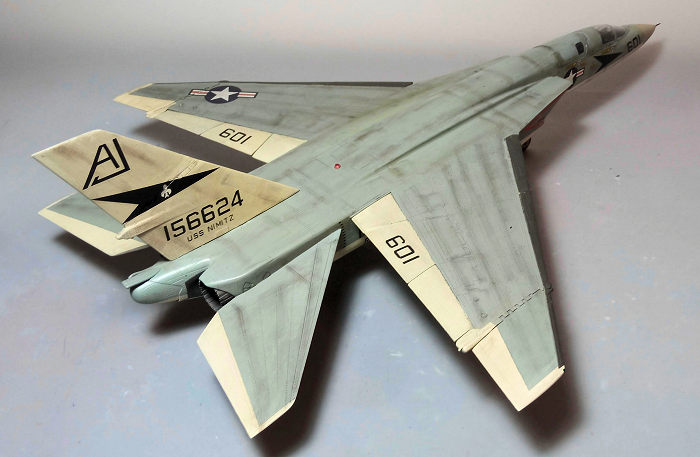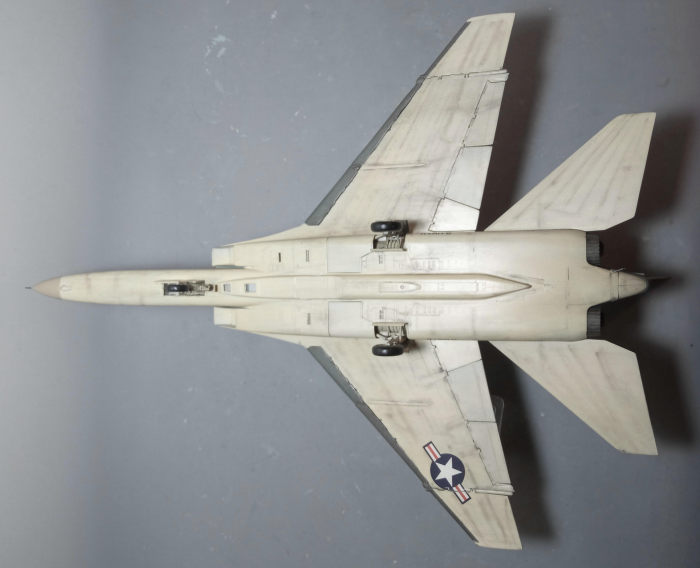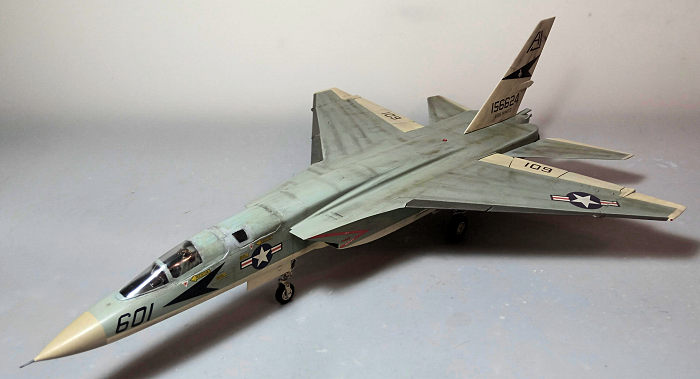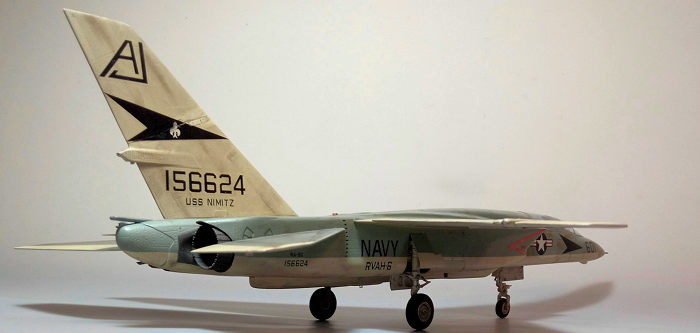
| KIT #: | 02809 |
| PRICE: | $75.00 |
| DECALS: | Two options |
| REVIEWER: | Spiros Pendedekas |
| NOTES: |

| HISTORY |
The twin engine, two crew North American Vigilante started its life as a supersonic carrier-based bomber, then maturing into a high speed reconnaissance aircraft. An effective but complex machine, it featured a high mounted swept wing with a boundary layer control system to improve low speed lift and a first generation fly-by-wire system. Roll control was provided by spoilers in conjunction with differential deflection of the all-moving tail surfaces, which were paired with a relatively large all-moving single vertical stabilizer.
The use of aluminum-lithium alloy for wing skins and titanium for critical structures was also unusual for the era, as was the use of a gold coating to reflect heat in key areas such as the bomb bay, which was in close proximity to the engines. The wings, vertical stabilizer and nose radome, all folded to enable easier stowage onboard aircraft carriers. The type featured very advanced electronics (multi role radar, HUD, computerized nav/attack system, radar equipped inertial navigation system and an under nose television camera), all coupled to a "Versatile Digital Analyzer" (VERDAN) digital computer.
Another particular feature was its "linear bomb bay", located between the engines in the rear fuselage, which would carry the primary weapon - typically a nuclear bomb - along with two disposable fuel tanks, with the complete set releasable rearwards at supersonic speed. Though sounding impressive on paper, the system proved troublesome in practice and never used operationally, with the space used to carry extra fuel when the type reverted to the reconnaissance role. Four hard points were also provided but hardly used.
 The sizable
plane, while surprisingly agile, was not the easiest to land on carriers, mainly
due to its high approach speed and high angle of attack. Its early service
proved troublesome, as the technology available and the personnel's initial
experience were not up to the standards the plane’s sophisticated systems
required. Even though those issues were subsequently worked out to a good
degree, the plane remained maintenance intensive. The shift that took
place by those times in the U.S. Navy's strategic role, emphasizing
submarine-launched ballistic missiles rather than manned bombers, gave the
death’s kiss to the plane's envisaged bombing role, allowing it to quickly
mature to a potent reconnaissance platform.
The sizable
plane, while surprisingly agile, was not the easiest to land on carriers, mainly
due to its high approach speed and high angle of attack. Its early service
proved troublesome, as the technology available and the personnel's initial
experience were not up to the standards the plane’s sophisticated systems
required. Even though those issues were subsequently worked out to a good
degree, the plane remained maintenance intensive. The shift that took
place by those times in the U.S. Navy's strategic role, emphasizing
submarine-launched ballistic missiles rather than manned bombers, gave the
death’s kiss to the plane's envisaged bombing role, allowing it to quickly
mature to a potent reconnaissance platform.
In the reconnaissance role, the Vigilante saw extensive service in the Vietnam War. Truth is that it suffered heavy losses there, but this was mainly due to the hazard of the missions themselves (medium-level, with especially the post-strike ones being, understandably, extremely risky) rather than the type’s inefficiency (in fact it was potent and useful). Meanwhile, the type's complexity made it expensive to operate and its big size for a carrier plane was not helping either, so it came as no surprise that it was quickly phased out from service after the Vietnam War, the last flight of the type taking place on 20 November 1979.
The Vigilante is an interesting case of an aggressive design that managed to enter operational status. Arguably “ahead of its time” and gradually addressing its teething issues, it matured to a capable reconnaissance platform. Potent, but maintenance intensive and very expensive to operate, this impressive, aesthetically pleasing aircraft had no chance but to remain in service for not that long.
BuNo156624 was constructed in January 1970 as an RA-5C and was immediately transferred to RVAH-6, NAS Albany, GA. Initially serving with USS America, she was then successively transferred to NAS Key West, USS Constellation, USS Forrestal, Key West and USS Forrestal again and finally USS Nimitz, where she spent its last operational time, being Struck Off Strength/Charge on 11 October 1978, spanning a too short career of less than 9 years. Luckily, she found a new life immediately after as a museum exhibit in NAS Pensacola Museum, where she happily resides outdoors today (2024), in seemingly very good condition.
| THE KIT |
 Listening to
modelers' wishes for the "Most Wanted Kit", Trumpeter came in 2005 with their
modern, detailed 1/48 Vigilante. After the initial praise (the kit looks very
comprehensive and promising in the box) complaints started to arise, mainly
focusing on shape issues and the fact that the kit was a mix match of earlier
and later airframe configurations, fit and exaggerated engraved riveting.
Whereas their significance might vary from one modeler to another, the above
reported issues had a negative effect, the bottom line being that the kit
everyone wanted did not sell that well, let alone being built.
Listening to
modelers' wishes for the "Most Wanted Kit", Trumpeter came in 2005 with their
modern, detailed 1/48 Vigilante. After the initial praise (the kit looks very
comprehensive and promising in the box) complaints started to arise, mainly
focusing on shape issues and the fact that the kit was a mix match of earlier
and later airframe configurations, fit and exaggerated engraved riveting.
Whereas their significance might vary from one modeler to another, the above
reported issues had a negative effect, the bottom line being that the kit
everyone wanted did not sell that well, let alone being built.
Personally I could not resist buying and tackling the kit, with my copy bought in 2008 from a sadly now closed Athens hobby shop and for an in-depth look at its contents you may read Tom Cleaver's preview found at the ever growing MM archives.
| CONSTRUCTION |
I started by putting together the quite detailed cockpit, which comprises a whopping 30 parts. Basic cockpit color, including seat frames, was Hu140 Gull Gray, instrument panels, side consoles, top dashes and stick grip were painted black, seat lower cushions were painted olive drab and upper cushions red, whereas ejection handles were black/yellow. The nose bay side walls were then attached underneath the cockpit floor.
The comprehensive J-79 engines were next assembled and attached (one at each fuselage half). Since everything but the nozzles are invisible once the fuselage is buttoned up, I only painted the nozzles and afterburner Testors Burned Metal. After attaching the 4-piece main bays sidewalls from the fuselage innards, I joined the fuselage halves, trapping the cockpit/nose bay assembly in between. Since the wide-body fuselage is split vertically, I attached a good number of styrene pieces underneath to reinforce the joint and avoid flexing/sagging once the wings are attached (alternatively, you may use the superb Nautilus Models internal brace, that conveniently contains nice FOD covers to blank the intakes sparsity).
 The rear top
fuselage cover was then attached, followed by the three piece tail hook and its
cover in “closed” position, the one-piece engine shroud and the small tail cone
antenna. The 3-piece intakes were assembled and attached, having their innards
painted white. The distinctive gondola was glued underneath, followed by the
nose, where roughly 30 grams of fishing weights were trapped in, to avoid tail
sitting. Finally, the TV optical scanner transparency was attached underneath
the nose.
The rear top
fuselage cover was then attached, followed by the three piece tail hook and its
cover in “closed” position, the one-piece engine shroud and the small tail cone
antenna. The 3-piece intakes were assembled and attached, having their innards
painted white. The distinctive gondola was glued underneath, followed by the
nose, where roughly 30 grams of fishing weights were trapped in, to avoid tail
sitting. Finally, the TV optical scanner transparency was attached underneath
the nose.
Onto the wings, where Trumpeter provides all moving surfaces separate, including
the folding outer section. While sounding impressive, this engineering also
means that each wing comprises no less than 16 parts which will give the modeler
a challenging time putting everything together, especially if choosing to go for
the moving surfaces in “neutral” position, which is the normal stance of the
Vigilante (and it is the stance that I chose, together with unfolded outer
sections).
Tackling the wings, their non-moving structural parts were assembled and attached to the fuselage, followed by assembly of the flaps and spoilers, which were left off, to facilitate painting. The tail planes and 4-piece rudder were also assembled (the latter was also chosen in unfolded position), with all above also left off.
Overall fit presented some challenges, mainly at the fuselage halves, the wing roots and intakes to fuselage joints. Gaps were initially treated with liquefied styrene and then with “normal” filler. After a couple of filling and sanding rounds, I blanked the cockpit and intakes with wet tissue, masked the undernose TV optical scanner transparent section and took the bird to the paint shop!
| COLORS & MARKINGS |
 I first gave
the radome a coat of Hu103 Cream, then masked it off and gave all undersides,
the main wing moving surfaces, the tip outer sections, the tail planes'
rear areas the complete rudder, the wheel bays and door innards a coat of Hu130
white. After masking all needed areas, I went on and gave the remaining a coat
of Hu127 US Ghost Gray. Upon drying, after some more masking, the main wing
leading edges were painted gunmetal, with a coat of Future preparing the bird
for decaling.
I first gave
the radome a coat of Hu103 Cream, then masked it off and gave all undersides,
the main wing moving surfaces, the tip outer sections, the tail planes'
rear areas the complete rudder, the wheel bays and door innards a coat of Hu130
white. After masking all needed areas, I went on and gave the remaining a coat
of Hu127 US Ghost Gray. Upon drying, after some more masking, the main wing
leading edges were painted gunmetal, with a coat of Future preparing the bird
for decaling.
I used the kit decals, to represent the aforementioned #156624 machine, wearing
its last operational scheme when in USS Nimitz. The decals behaved beautifully,
easily detaching from their backing paper and nicely adhering to the model, with
the aid of mild decal softener. To my understanding, the decals were made by
Cartograf, so their excellent behavior came as no surprise. A coat of Future
sealed them.
| FINAL CONSTRUCTION |
The landing gear legs were assembled and attached, followed by the wheels and doors, with the bird standing on its feet. All landing gear bits, bays, door innards and wheel rims were painted white, while tires were painted black. As a note, the landing gear is tad on the sensitive side, so better be delicate when handling the completed model.
I
then went on attaching all flaps and spoilers in "neutral" position. The
vertical stabilizer and tail planes were attached at this time as well, the
latter slightly "drooped", as was their observed stance on the g round. Though
tempted, I neither attached the wing tanks nor the very interesting looking wing
mounted flash pods as, to my understanding, those bits were rarely used.
round. Though
tempted, I neither attached the wing tanks nor the very interesting looking wing
mounted flash pods as, to my understanding, those bits were rarely used.
I then went on performing some weathering, mainly consisting of a black wash at the landing gear area and application of dark dry pastels at all areas where dirt, grime or even engine staining would accumulate. I was not too soft on weathering, hoping it would cover an amount of my less than perfect overall job (and, possibly, emphasizing the harsh carrier environment, though those birds were typically kept in very good condition). An almost matt coat gave the bird its final hue.
The nice looking (but, as it turned out, not well fitting) transparencies had their well defined frames hand painted and attached in my go-to closed position. As the canopies proved to be narrower than the already painted fuselage, there was little I could do, other than somehow even the “step” with some white glue (in retrospect, going for “open” canopies would have been preferable here, as the width mismatch would have been “blanked”). As a note, the HUD was also installed, probably a mistake for the RA-5Cs, as they typically did not carry any. The various small bits (pitots, small antennas and the like) were also attached in position. Finally, blobs of red and green clear paint represented the wingtip lights and top beacon, before calling the iconic reconnaissance bird done!
| CONCLUSIONS |
This is a case of a nevertheless adequate kit that has its advantages and disadvantages. On the one hand, it is “modern”, with crisp molding, good overall detail and great decals. On the other hand, fit is in areas challenging and there are accuracy issues, both dimensional and also dealing with configuration (earlier or later airframes and so on). The excessive engraved riveting is not to everyone’s liking either. Regarding accuracy, truth is that, though the issues do exist, they might neither be too obvious nor too significant to a number of us who are not Vigilante Experten.
Though building the kit will require your extra attention, the outcome can be outstanding, as is the case with Lee Colosna's 2009 amazing result. Still (2024) your only 1/48 choice and not exactly cheap, this kit is a solid base for a detailed Vigilante, with a good amount of aftermarket stuff available, promising not only to address a number of the kit's shortcomings, but also to boost the final model looks.
Happy Modeling!
13 February 2024
Copyright ModelingMadness.com. All rights reserved. No reproduction in part or in whole without express permission.
If you would like your product reviewed fairly and fairly quickly, please contact the editor or see other details in the Note to Contributors.